Marketers have their eyes set on designing the perfect customer activation strategy for those existing customers who trigger repeated sales.
Why? It all goes back to an old adage:
20% of your customers are responsible for 80% of your sales. Share on XFollowing this statement, you might feel like you are ignoring something- because YOU ARE. You are focusing on that 20% set majorly. For this 20%, your customer activation marketing strategy must be prim and proper. The remaining 80% will continue to dwindle between “I need the pro version of this product” and “I can still do with the free version”.
Throughout a customer’s lifecycle, it experiences multiple touches with the company. The B2B marketing team is responsible for ensuring that every time you interact with customers delivers a positive impact and moves the customer to the next level.
However, many marketers wonder how they can measure the success of the efforts they put in and the positive impact they have on the customers lifecycle. This is a valid thought because they are not creating awareness only. This brings focus to create sustainable Customer Activation Strategy.
What is a customer activation strategy?
Customer activation strategy involves detailed planning to motivate existing customers to proceed to the next level of their lifecycle faster. It can be for an existing active customer, a dormant customer, a customer turning into an advocate, or also for a one-time customer that recently turned into a frequent user. There are times when customers will move through these stages by themselves. Even so, Customer Activation makes the process faster.

The customer activation plan successfully creates an impression that a marketer can influence the customer’s movement throughout the lifecycle faster. In today’s time, customer activation rate banks in three instances. Knowing:
- When to nudge a customer towards the next level
- When to push them
- When to let them be.
This sounds very simple and straightforward until you realize that you are dealing with millions of prospects or customers here.
In this guide, we will look at a framework that is strategic in helping you determine a vital fact. This will help you understand whether the customer activation program is perfect or the budgets and team’s efforts need a realignment. When you identify this, you will be able to ensure that your B2B marketing efforts result in customers flowing towards your set goals.
Note: Use a nudge to drive overall engagement and a push for conversion. Conversion includes a customer making a purchase, registering for an event, signing up for an offer, or referring a friend.
Know your customers
Customer engagement is more than cultivating value from engaging customer relationships. It also includes the delivery of value to the customer. A recent study revealed that customers are willing to pay higher for services that handle customer relations effectively.
Here is a question, how will you ensure that you deliver value throughout the lifecycle? Value delivery starts with a deep insight into your customers. You may have an understanding of your customers. But it is not enough to have this knowledge in your mind. It will only be beneficial to you if it is actionable. Therefore, you have to create your buyer personas and maintain them.
Still Not an User of Aritic PinPoint Automation?
Creating buyer’s persona
The buyer persona is a representation of your target audience. Each persona has to capture a unique element of the customer type and use it to engage them. This is possible by looking at factors such as the customer’s demographics, motivations, needs, behaviors, and transactions.
To create buyer personas, you need to conduct interviews with three categories of people. These categories include your:
- Current customers
- Prospective customers
- people who interact with customers in the workplace.
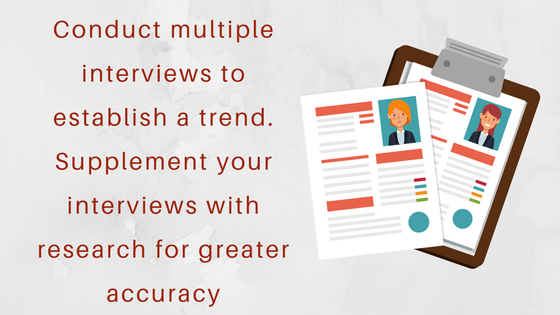
Many marketers struggle to identify the perfect number of personas to establish. I’d suggest developing as many as they want to, but also ensure that they can manage the numbers. Remember, for each persona you must create relevant content. You also have to analyze your customers and see the kind of persona they resemble. By doing so, you will be able to understand how content marketing works so that you can give them content that is relevant to them.
Tracking and monitoring online behavior
It is not a new practice to build personas as per the demographic information. In this digital world, we can now take into consideration the behavior of the customer regardless of their numbers. Understanding your customers by their demographic information shows you where they are. But understanding their behavior will show you what interests them.
With current personas, you have to understand their reactions. If you are sending irrelevant content repeatedly, chances are high that your customers will unsubscribe from your mailing list soon or worse, never visit or purchase from your website in the future. Here are some probable customer actions upon receiving irrelevant content.
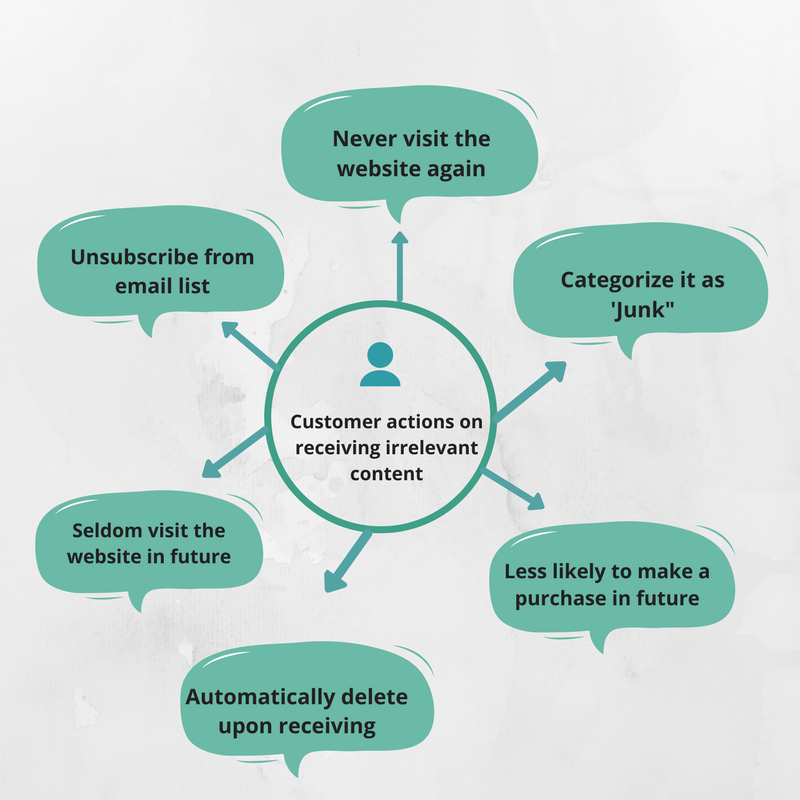
When you have a customer’s behavioral data, you will get a strong impression of their next step in the lifecycle. The browsing, searching, and social activities of a persona can indicate their interest. The medium that they use to get your information will show you what are channels that they prefer and the content they need. For instance, you can know whether they prefer your desktop version, mobile website, or your app.
Thoughts to consider
- What is my understanding of all my customer interactions with the brand?
- Am I capable of collecting all vital information about all my customers to see the kind of personas they are?
- What is my understanding of my primary customer personas and what motivates them to engage with the brand?
- Do I have the platforms I need to collect and understand the behaviors of my customers?
An insight into the customer journey
After identifying your personas, you need to outline the customer lifecycle stages. By doing so, you will be able to create a strategy that lets you communicate to all customers based on their position on the lifecycle.
Start mapping the stages through the lifecycle. Map the stages based on the customer behaviors that you identify. Carefully look at the channels that the customers use and the information that they desire at every stage that matter.
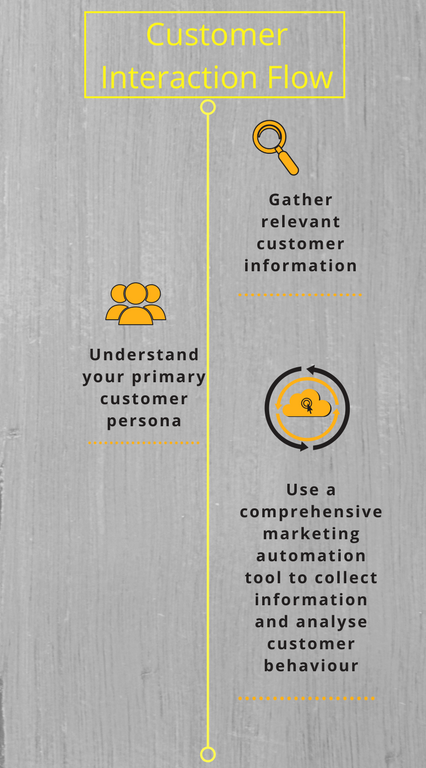
Remember to add the information about the initial engagement between the customer and the company. For this, you can consider factors like how the customer found the company, the message that resonated well with them, and what inspired them to give their contact information. This information makes it effortless to nurture the relationship with the customer. You will also learn the preferences of the customer when it comes to customer engagement.
Some customers will tell you upfront their communication method preferences, the frequency of communication, and the channels they like in comparison to other channels. Even so, not all of them will provide this information. Therefore, ensure you have ways of inferring the preferences of the customer so that your efforts can yield better fruits.
For example, you may notice that a particular customer rarely opens their emails. The next best step for you to take is to change the means of communication to SMS or Mobile push. Pick the method that best resonates with them.
Hold their starring and move the customer through their lifecycle with a lightning speed
At this point, you have a definition of your personas and customer lifecycle. You can now deliver content that is relevant and information that is personalized. The content will address their interests and lifecycle stages.
Before you proceed, you need to determine whether you are currently doing an excellent job in moving the customers through the lifecycle. There are two elements that marketers can influence regarding the customer’s lifecycle. These are the stage and the speed.
The stage and speed of the customer
First and foremost, you need to determine the stage you want to take your customers and the ones you want them to avoid. Identify the stage where customers get stuck in, and you want to move them out as soon as possible.
For instance, there is a stage where some customers become dormant after making their first purchase. Some customers can take more than a year before their next purchase. There is also a stage where customers are not buying your product. Find a way to engage them in this stage even if they are not buying.
You can also impact the customer’s speed of moving through the lifecycle. Typically, many marketers consider their final stage of the lifecycle to be advocacy. This is the stage where the repeat customer shares their experience with the brand and their friends. Therefore, getting your customers to this stage a lot faster will be brilliant.
As a marketer, understanding the lifecycle and the stages that are very crucial for the company. These are the stages that have the biggest advantages. From there, you can efficiently figure out how to move the customers to the positive stages a lot faster and keep them there for longer.
Have a goal that will help you to gain control over how customers move through the lifecycle. Having a goal will guide your vision and efforts. Also, remember to create content and campaigns that will affect all the touchpoints that influence how the customers move through the lifecycle. Do not ignore any stage in the lifecycle.
Questions to ask before you proceed:
- What are the stages that make up my customer’s lifecycles?
- Is the lifecycle an ideal one?
- What indicators will I use to know in which stage they are in?
- Can I measure the indicator automatically?
- How do I tell when a customer moves forward or backward?
- Are my efforts to reactivate dormant customers yielding excellent results?
Customer activation process in play
As a marketer, strive to have all your B2B marketing activities revolve around activating the customers. Activation is crucial for the progress of the company. In this framework, we will look at the marketing activities that have a powerful impact on customer activation. When you know, you can expand their influence and consequently have the outcomes that you desire the most.
Now, you have to identify the mechanics of activating your customers. I mean that you have to decide the interactions that have higher chances of moving the customers to the next level from a particular touchpoint.
Drive customer engagement
Look at the current marketing activities and break them into those the facilitate engagement. Break them into those that nudge and those that push the customer. Remember, nudges head towards engaging the customer while push heads towards customer conversion.
Document these activities and carry out campaigns around them to observe the results that the activities will yield. Make use of the 4-1-1 rules in your campaign design. These are four nudges with content assets that are fun and engaging for all soft pushes like coupons and hard pushes such as direct promotions. These are the primary touchpoints of Customer Activation. Combine them and test them to see the one that gives the fast results of moving customers.
For instance, you may have a customer who does not buy products as frequently as you want them to buy. The course of action may be a nudge using fun content and a soft push. The soft push can be a discount offer if they make an immediate purchase. If this does not work, another approach may be to use two nudges and a hard push. Make your call-to-action crystal clear for the hard push.
By measuring and testing the tactics, you will have a clear knowledge of what works in building engaging customer relationships. You will know what makes them purchase products and everything else that you need to scrap off.
Your platform for engagement marketing
When a B2B marketing platform is perfect, it will help in automating the marketing automation processes and creating interactions that are meaningful to the customers. With an engagement platform in place, there will be the excellent facilitation of interactions based on who the buyers are and what they do. It is marketing the catapults your customers to new levels in their journey. Therefore, you cannot take it lightly.
To make things easier, log in to your Aritic PinPoint dashboard to implement your consumer activation ideas ASAP. Your Aritic PinPoint dashboard will instantly give you an overview of your active contacts, total contacts, and marketing churns.

You can do communication management with all personas and stages seamlessly. It also helps in automating these interactions, making the work smooth. This means that you do not have to manage the entry and exit of personas in different stages manually. Now, you can automate the persona engagement in all their entry and exit activities.
Execute Effective Marketing Automation Workflows Now
When running activities on Aritic PinPoint (or any other engagement platform), you must keep a tab over the metrics and insights of your customer activities. These will help you to know the right times to push or to nudge your customers so that you get them to do what you want them to.
You will also be able to deliver the right content to the customers, using the right channel, and at the right time. Using Aritic PinPoint, you can cap the frequency of your marketing messages, implement ad orchestration, create push campaigns to engage on mobile (And web) along with other commonly used B2B marketing channels.
For instance, a customer may be a frequent visitor to your website. She may not purchase the product for a while. But as she accesses your information, you will learn about her navigation habits and the places she likes to visit while on the website.
The data that you collect will help you to personalize the content of the site and the offers. At this juncture, you can keep adding activity scores (or deducting points) so that after a certain time span you can go over to see which customers have the highest lead score. The higher the score, the closer they are to becoming your delighted customers.
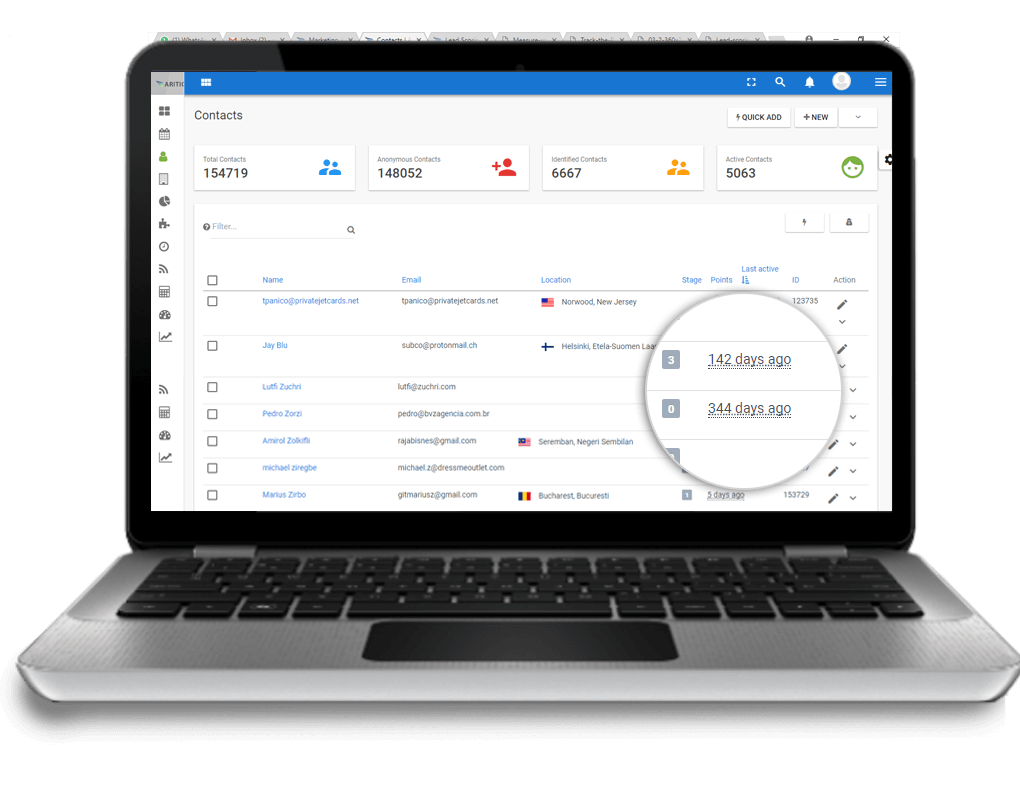
When they give you their email addresses, you can deliver the same messages when they are offline. When they log on, they will see the message. When such a person makes a purchase, you can embark on nudging them towards the next stage without hesitations. From there, you will be able to turn them into consistent customers. Also, with the email workflow and address and navigation behavior in hand (along with other customer information), you can build drip email series based on customer behavior. This helps in keeping the customer in the loop with relevant information. Here is a quick campaign flow for an existing customer who submits a form for an event.
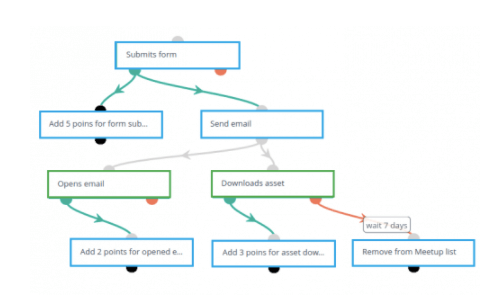
Takeaways:
- What are some of the changes we want to see on the optimal journey?
- What point do we need to move the customers speedily to the next stage?
- Which marketing activities efficiently engage the customers currently?
- Which marketing activities efficiently convert customers currently?
- Can we direct our push activities to people who are ready for conversion?
All journeys end up in a specific place
Customer Activation’s primary purpose is to move the customers through the lifecycle. Even so, it does not end with the journey because the destination is more important. The destination here means the marketing goal that you desire to attain. The ultimate goal is to turn all customers into advocates. You can measure how effective you are in moving customers out and into different stages. All you need is entry and exit points that have precisely defined criteria.
Let us take our previous example where the B2B marketing strategy turned the visitor into a first-time customer. Let us assume that the marketing strategy turned her into a repeat customer after a while. Two things should be on your mind at this point. These are; finding a way to make them keep coming back and a way to turn them into an advocate.
For now, you know that you are on the right track because the client came back. Continue learning more about them and their behaviors as you keep interacting and engaging them. The moment that you see her talking about the product on social media you can rest comfortably and know she is an advocate for the brand.
The above example shows us how a customer may move through the stages of a lifecycle. The lifecycle of the customer has to reflect the path they take while engaging with the company. It also has to show the way that you want the customer to take.
The lifecycle may be different for all your customers. Even so, put in place definite metrics that revolve around your desires concerning how they should move through the lifecycle. The easiest way to do this is by identifying measurable customer behavior. These metrics can be their first purchase or them sharing the information about the product through a social channel.
Key questions to consider:
- Can I be able to determine the time when a customer moves to a new stage in the lifecycle?
- What are the behaviors that my customers display when they change their stages?
- Will I be able to detect the behavioral changes and act on them automatically?
Design a marketing plan to achieve your target ROI (and more)
At this point, you have to cross-reference your criteria and patterns for entry and exit with the number of persons you need at the lifecycle’s top and on every stage to realize your goal. When you do so, you will know if your marketing budget allocation is excellent. If the efforts do not suffice for the objectives, you have at each stage, tweak the budget.
Once you have done so and you can perceive the results, analyze the marketing efforts carefully. Remember that all your Inbound marketing activities need to link to the goal of moving customers to the next levels. Therefore, eliminate any effort that does not help you achieve this and amplify those that contribute to the journey.
What you should be asking yourself:
- How many people are currently in each stage of the lifecycle?
- How many people does each stage need to accomplish the goal of the business?
- What improvements can we incorporate to enhance the speed of customer movement through the lifecycle?
- What kind of investments do we need to make to ensure more people move to the desired lifecycle stages?
Is your organization customer-centric?
Many organizations have a traditional structuring. Their organization revolves around a single channel, product, or geography. In this era, customers span channels, products, and sometimes geographies. They cut across the silos that companies have made it impossible to have a customer-centric organization. But what is customer centricity? Well, it’s the ability of an organization to understand customers’ situations, perceptions, and expectations.
For a customer activation strategy to be sufficient, you need to organize your marketing activities and company around the customer. If your company is more about channels, then you must have processes that will coordinate the journey of the customer across the numerous available channels. But my vote is for a customer-centric organization. Strive to be customer-centric and organize around the personas and stages. This will offer you a cohesive experience across all channels and lifecycle stages. This will consequently improve the effectiveness of all touchpoints in marketing.
Final questions:
- Do our customers enjoy a unified experience with our brand? Does the united experience start immediately after they convert?
- Does the marketing team coordinate all the experiences so that customers can have a unified experience across silos?
- Can the marketing team go through a re-organization to enhance the cohesiveness of the customer experience?
Does your marketing automation platform support your approach?
We are in a digital world where accessing, viewing, and analyzing customer data is possible. You can obtain their behavioral, demographic, and transactional information. This is enough to give you a perfect picture of the customers.
Even so, for you to have the perfect 360 degrees view of the customer, you must alight the customer data, technology, processes, and people. By aligning the above, you will measure the customer’s engagement throughout their lifecycle.
Because of the changes and the capabilities, you can adopt a customer-centric view that will fuel to create a sustainable marketing strategy and the tactics you have. With the insight you have, you will engage your customers and all stages of their lifecycle excellently.
For this framework to work exceptionally well, you must have a platform that will give you a single view of the customers on all channels. The platform has to enable to you measure how the customers move through the lifecycle.
It is mandatory to have a solid customer lifecycle support
The platform that you have in place has to automate user engagement. It is impossible to interact with thousands and millions of consumers manually. They make entrances and exits at each stage of the lifecycle.
A smart marketer will shift from a perspective that focuses on a channel or product to one that is customer-centric. It may seem impossible to make such a massive shift. Even so, the content in this guide gives you a framework to work with so that you can start to align your efforts with the customer cycle.
When you have a perfect Marketing automation platform and processes, you can:
- Create a single view of the customer across multiple channels
- Enhance the speed of movement through a customer’s lifecycle
- Measure the excellence of your marketing efforts in moving customers through their lifecycle.
Aritic PinPoint comes with bi-directional sync with CRM that will make your tasks much easier. You can take note of the entry and exit points of each of your customers, look back at all the conversations you’ve had with your customers since the beginning of time. Since Aritic PinPoint supports dynamic segmentation, your customer lists will be automatically updated based on the recent behavior of your customers.
We are done with the theoretical part of the customer activation strategy. Here is a practical workbook, or should I say, 25 basic questions that you need to answer to yourself or discuss with your team before you start designing a customer activation plan (or implement your already designed strategy). These questions will also allow you to look deep into your previous strategy and understand where you excelled and where it was flawed.
Workbook for Customer Activation Strategy: 25 Questions to Ask before you start
- What is my understanding of all my customer interaction with the brand?
- Am I capable of collecting all vital information about all my customers to see the kind of personas they are?
- What is my understanding of my primary customer personas and what motivates them to engage with the brand?
- Do I have the platforms I need to collect and understand the behaviors of my customers?
- What are the stages that make up my customer’s lifecycles?
- Is the lifecycle an ideal one?
- What indicators will I use to know in which stage they are in?
- Can I measure the indicator automatically?
- How do I tell when a customer moves forward or backward?
- Are my efforts to reactivate dormant customers yielding excellent results?
- What are some of the changes we want to see on the optimal journey?
- What point do we need to move the customers speedily to the next stage?
- Which marketing activities efficiently engage the customers currently?
- Which marketing activities efficiently convert customers currently?
- Can we direct our push activities to people who are ready for conversion?
- Can I be able to determine the time when a customer moves to a new stage in the lifecycle?
- What are the behaviors that my customers display when they change their stages?
- Will I be able to detect the behavioral changes and act on them automatically?
- How many people are currently in each stage of the lifecycle?
- How many people does each stage need to accomplish the goal of the business?
- What improvements can we incorporate to enhance the speed of customer movement through the lifecycle?
- What kind of investments do we need to make to ensure more people move to the desired lifecycle stages?
- Do our customers enjoy a unified experience with our brand? Does the united experience start immediately after they convert?
- Does the marketing team coordinate all the experiences so that customers can have a unified experience across silos?
- Can the marketing team go through a re-organization to enhance the cohesiveness of the customer experience?
Do you have any experience with customer activation marketing? Are there any struggles that you face? What were your solutions? Let us know all about your experiences in the comments section below. Let’s keep learning till then.
⭐ What is the customer activation strategy?
Customer activation strategy encourages customers with detailed analysis to move towards the next level of their customers’ lifecycle.
⭐ What is an activated consumer?
Customer activation motivates buyers to realize the benefits of the product and promotes brand engagement with new customer generation.
⭐ How to track customer online behavior?
Marketers track customers’ behavior through permission-based tools like cookies, IP mapping, device IDs, geolocation, and obtain comprehensive real-time insights. Sometimes you may need to use VPN. Services such as cooltechzone will help you figure it out better.
⭐ What is the best Customer Activation Strategy?
The best customer activation strategy is to create a buyer’s persona for reaching out to the target audiences. Understand the buyer’s behavior, transactions, and requirements for offering them the best products and services.
⭐ What is customer activation process?
The customer activation process is the methodology to motivate customers for understanding the benefits of any product or service. The interaction between customers’ behavioral actions and environmental factors helps to make the purchase decision. In pre-purchase behavior, customers search about the brands based on their requirements. Then, customers experience post-purchase dissonance after making the purchase.
⭐ What is an activation concept?
An activation concept is an integral part of a marketing mix. It is used to deliver the marketing message and ultimately fulfill the objectives set forth during the development process. The goal of any activation concept is to provide people with an experience that engages them so that they remember your business and come back for more.
⭐ How do you define customer engagement?
Customer engagement is when you are able to connect with your customers in a way that makes them feel involved in the process. Engaging your customers will keep them coming back for more, and make sure they spread the word about how much they love your products or services.
⭐ What is loyalty customer?
A loyal customer is a customer who, over time, has developed an emotional attachment to the brand. This can be accomplished by giving them more value at any point of contact.

![9 Hurtful Marketing Automation Workflow Mistakes You Must Avoid [+ Ready-to-use Workflow Templates] Marketing Automation Workflow Mistakes (1)](https://aritic.com/blog/aritic-pinpoint/wp-content/uploads/sites/3/2019/06/Marketing-Automation-Workflow-Mistakes-1-770x500.png)

![[Lead Experience Guide] 5 Ways to Generate Quality Leads With Chatbot Integration](https://aritic.com/blog/aritic-pinpoint/wp-content/uploads/sites/3/2019/06/chatbot-integration-cover-2.png)
10 Comments
Thanks for sharing your knowledge and all of these tips and tricks. I learnt a lot of things I wouldn’t have considered before.
Thanks a lot, Pritha for sharing this article about the customer activation strategies so that any marketer can stay ahead of everyone in the market.
Good reads. Looking forward to reading such blogs in the future too.
Well written blog! Pritha.Thank you for sharing this useful information with us. This post gave me a lot of experience and knowledge about customer activation strategies. Keep it up.
Customer Activation Strategy is the excellent marketing tactics. Thanks, Pritha for sharing such a detailed piece of information.
Thanks for the valuable information. It’s really helpful to me to gain a clear understanding and overview of customer activation strategy.
Thank you very much for this super insightful and well thought out article! Have scribbled a lot of helpful notes from this as a newbie!
I was looking for the same as it is one of the best marketing tactics. Great work, Pritha.
It is great that this article also provides a worksheet along with some really important tips. Great work Pritha!
With the acceleration in the digital age, the speed of innovation is difficult to keep up with. Keeping up with changes in how customers are making purchases in your company can be particularly difficult.